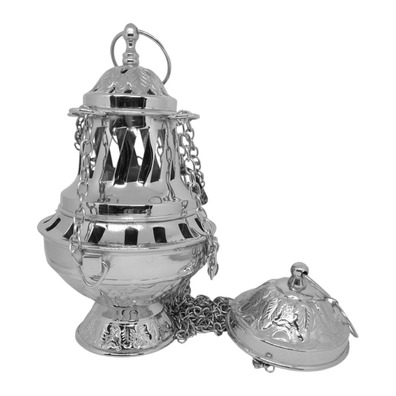Censer for Holy Week | Liturgical incense burner
145,00€
Taxes includedCatholic product in stock. Products ready to be shipped. You can check the approximate delivery time during the purchase process.
Censer for Holy Week | Liturgical incense burner
- Censer made of silver metal.
- 24 cm Tall.
- Removable incense container with 8 cm. in diameter and 5 cm. depth.
- 7.50 cm. diameter circular base decorated with elements in relief.
- Four chains hooked in the burner area.
- Central chain attached to the upper end of the thurible.
- For sale other Easter censers in other colors and sizes.
Origin of the Use of the Censer During Easter Processions
Easter processions are deeply related to liturgical celebrations in which the Passion, Death, and Resurrection of Christ are celebrated.
The origin of incense as a liturgical element is not fully defined, but it is already reflected in several passages of the Bible.
Firstly, incense is one of the three offerings that the Magi brought to the newly born Jesus. Melchior, Caspar, and Balthazar, the Three Magi, guided by the Star of Bethlehem, arrive at the Portal to offer gold, incense, and myrrh. Incense was a symbol at the time of recognizing divinity. It was tradition in those years to burn incense to highlight the presence of God.
We can also read in the Bible, more specifically in the first chapter of the Gospel of Saint Luke, the Annunciation to Zechariah. At this moment, the archangel Gabriel announced to Zechariah, a priest of the Temple of Jerusalem, that he would have a son with his wife Elizabeth, who was sterile and of advanced age. The archangel told him to name him John, and that he would be the precursor of Christ. This significant event occurred while Zechariah was burning incense in the temple.
Meaning of the Use of the Censer in Easter
Burning incense during brotherhood processions has a meaning linked with Catholic liturgical celebrations. The use of the censer to burn incense during Easter carries great symbolic weight.
-
Purification, blessing, and respect
The act of incensing, a process in which incense is burned in a censer, blesses people and places. It is also employed before the presence of Christ, the Virgin Mary, and other saints as a show of respect.
-
Presence of God
The smoke and scent of incense have been linked from the beginning of humanity with the presence of God. Employing the censer at certain moments of liturgical and brotherhood celebrations highlights the closeness of Christ.
Burning incense helps to connect the earthly world with the heavenly world, putting people in a predisposition to approach the word of God.
-
Religious Atmosphere and Reflection
Easter is a time of reflection, of contemplation, and of mourning. During the celebration of the Passion, Catholics acknowledge the sacrifice that Christ made for us, to grant us eternal life. Incense helps to create an appropriate atmosphere for the brethren and attendees at the processions to recall the significance of the events that are celebrated during Easter.
The Censers of Easter in Loja (Spain)
Censers, the incense burners, play an important role in most Easter celebrations.
There are places where censers have a leading role. Such is the case of the town of Loja, in Granada (Spain).
In the celebration of Easter in Loja, a Festival of Tourist Interest in Andalusia, there has been for centuries the tradition of the Censers, members of Brotherhoods and fraternities who are named for carrying censers.
There is documentation confirming the existence of "corrías" of censers accompanying the local Brotherhoods in processions since the 18th century.
The members of the "corrías" swing the censers producing sounds with the chains, in addition to singing songs known as satires. These traditional compositions are centered on elements of Easter such as the Death and Resurrection of Christ, the sorrows of the Virgin, etc.






